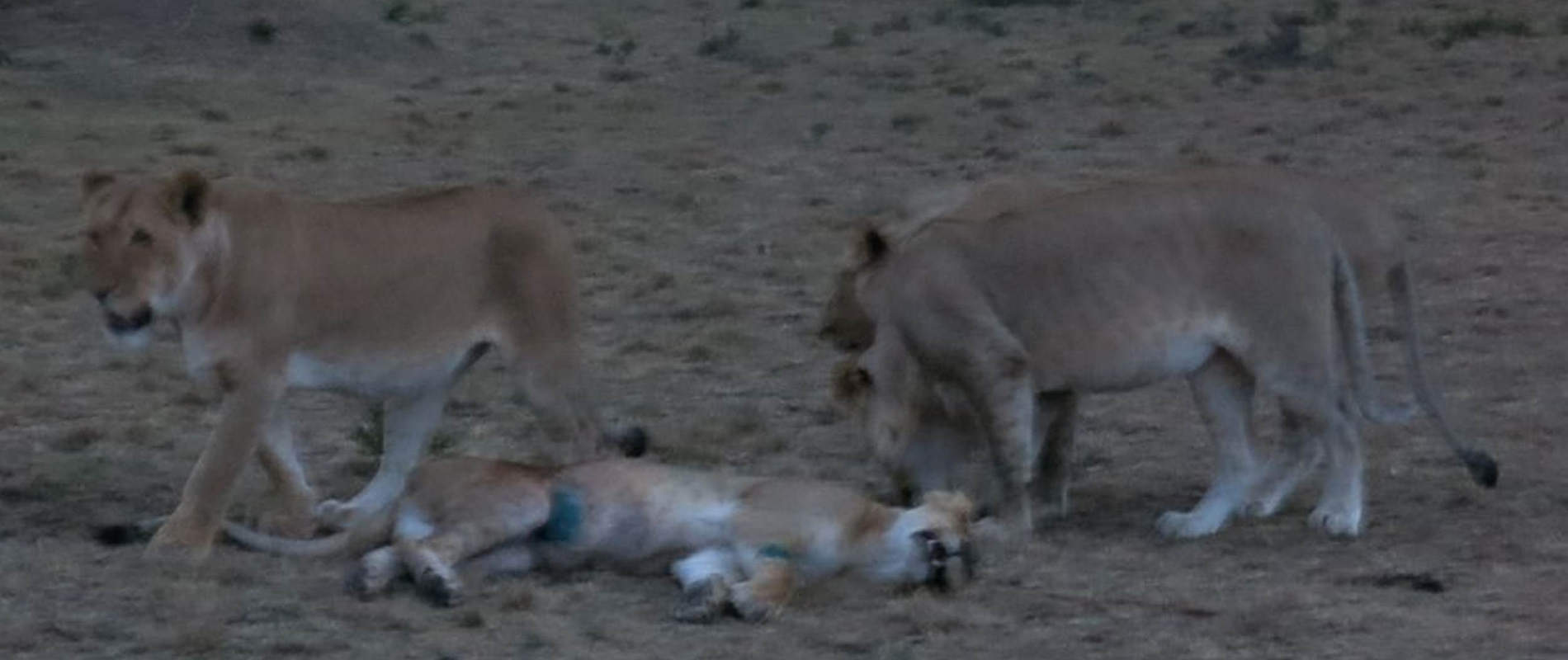MONTHLY VETERINARY REPORT FOR MASAI MARA-MARCH 2015 Reported by Dr
MONTHLY VETERINARY REPORT FOR MASAI MARA-MARCH 2015
Reported by Dr.Campaign K. Limo
Introduction
For the third month running the Masai Mara ecosystem has remained dry. However the herbivores still have something for sustenance, except the hippos who find it hard to cope with the decreased water level, excessive heat and unpalatable pasture. There were however signs of impending rain towards the end of the month which hopefully will lead to pasture regeneration.
This month there was an increase in cases across the species compared to the previous month. This included the rescue of a baby elephant and a nasty incident involving a potentially fatal spearing of an elephant which required a procedure to secure intestinal organs from popping out.
Below are cases handled during the month
CASE#1 TREATMENT AND COLLARING AN ELEPHANT WITH A SPEAR WOUND
Date: 4th March 2015
Species: African elephant
Sex: Male
Age: Adult (30-35yrs)
Location: Mara Triangle Conservancy.
History
For ease of monitoring elephants and subsequently advising management on their movements, The Save the Elephant and Mara Elephant Project teams partnered with KWS to collar a few elephants within this ecosystem. This male was identified and chosen because he is said to move occasionally up the escarpment and into agricultural farms. He also had a suppurating wound to the right hand side of his rump which required intervention. It was therefore sensible to immobilize him and perform both procedures.


Immobilization, examination, treatment and collaring
This elephant was immobilized by use of 16mgs Etorphine Hydrochloride delivered through a 3ml Dan-inject dart from a vehicle. The drugs fully discharged but the elephant would not go down. He showed partial narcotization and after 25minutes of waiting, a top up dart with 5ml Etorphine was prepared and the elephant was darted a second time. The drugs took effect after four minutes with the elephant assuming right lateral recumbency position. This became a disvantage because the wound was on the right side and became hard to access. Meanwhile; the collaring team was advised to continue fitting the GSM/Satellite collar before the elephant was turned over to clean the wound. The elephant was flipped over by use of ropes and a vehicle.
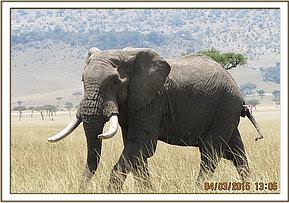

Examination of the injury revealed a suppurating old wound about to heal that appeared to have been caused by a spear. The wound was cleaned by use of Hydrogen peroxide and copious amount of water after ensuring all the pus was drained out. Tincture of iodine was then used to disinfect and Oxytetracycline spray was applied topically. This elephant was given 15000mgs Amoxicillin antibiotic intramuscularly.
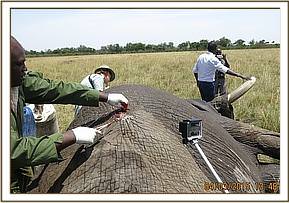

Reversal
Reversal was achieved by intravenous administration of 60mgs Diprenorphine hydrochloride through the ear vein. After making five attempts to wake up, the elephant was assisted with ropes and a vehicle and eventually he rose and dashed to a nearby bush.


CASE#2 TREATMENT OF A MALE CHEETAH
Date: 6th March 2015
Species: Cheetah
Sex: Male
Age: Adult (8 years)
Location: Masai Mara Game Reserve near Fig Tree
History
This cheetah and his brother were seen by the Meru Mara cheetah project team who reported the matter to the Mara Vet Unit. On arrival the vet team found him resting under a tree with his brother. He had a slightly swollen left cheek with moderately drooping left lower jaw.
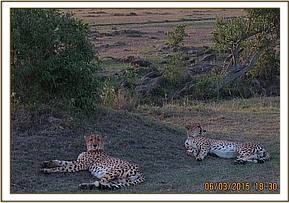

Compared with the brother, he appeared dull although he had reportedly killed and feasted on a young wildebeest. His frequent yawning afforded the team an opportunity to examine the oral cavity from a reasonable distance with good binoculars. The two premolars on the left lower jaw were missing and the gum around this area appeared inflamed. Physically, no other abnormality was evident with this cheetah
Treatment
The team decided to remotely deliver antibiotics to prevent sepsis and a 3ml Dan-inject dart containing 300mgs Clindamycin antibiotic was prepared. The drugs were delivered remotely intramuscularly to the gluteal muscles and the dart fell off as soon as the drugs were discharged. The cheetah was monitored for half an hour after treatment and when the team was satisfied he was comfortable; he was left to relax with his brother.
Prognosis
Good; it was reported the swelling finally subsided.
CASE#3 RETREATMENT OF AN ELEPHANT BULL
Date: 7th March 2015
Species: African elephant
Sex: Male
Age: Adult
Location: Olkinyei conservancy.
History
This massive bull was treated one month before for a suspected sprain of the right forelimb. He had since shown marked improvement and walked with ease but it was felt necessary to give him additional treatment to quicken the healing process. Olkinyei and Naboisho Conservancy Rangers had been monitoring this elephant and it was easy to find for the second and hopefully final treatment.
Immobilization, examination and treatment
This bull was in company of an equally big elephant bull. The bull to be treated was darted with 16mgs Etorphine hydrochloride in a 3ml Dan-inject dart from a vehicle.
The drugs took full effect after eight minutes with the elephant going down on his left lateral. Examination of the affected limb revealed substantial reduction in swelling and more mobility of the carpal joint compared to earlier state. He was given an intramuscular injection of 15000mgs amoxicillin antibiotics and 4000mgs Flunixin meglumine anti-inflammatory.
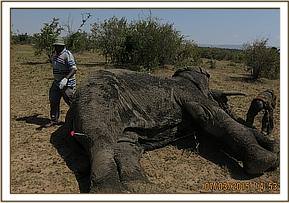

Reversal
Revesal was achieved by administration of 48mgs Diprenorphine hydrochloride intravenously through a superficial ear vein. He got to his feet three minutes after reversal to join the other bull.
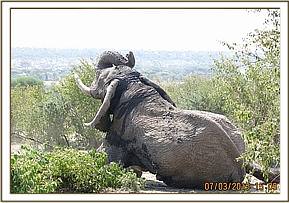

Prognosis
Good.
CASE#4 DESNARING A GIRAFFE
Date: 8th March 2015
Species: Masai giraffe
Sex: Male
Age: Adult
Location: Masai Mara Game Reserve (Musiara)
History
While on their normal patrols, the Masai Mara Game Reserve rangers came across this big bull giraffe with a snare around its neck. They called the Mobile Veterinary Unit to help remove the snare.
Immobilization and de-snaring
This giraffe was immobilized with a combination of 12mgs Etorphine hydrochloride and 50mgs Azaperone delivered through a 3ml Dan-inject dart from a vehicle. The drugs took effect after ten minutes and the giraffe was pulled down with the help of ropes. He was blind folded and cloxacillin ointment applied to both eyes. The wire was cut and released from the neck .It was a plain wire which had not caused any injury.
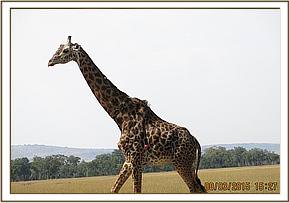
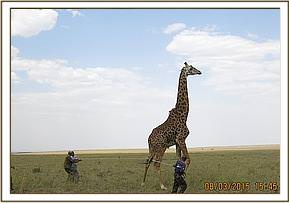
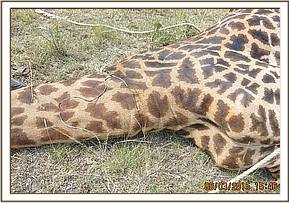

Reversal
The giraffe was reversed immediately after removal of the snare by use of 36mgs Diprenorphine hydrochloride administered intravenously through the jugular. He rose immediately to join the rest of the herd waiting nearby.
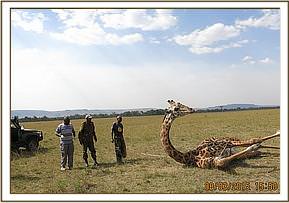

Prognosis
Good.
CASE#5 DESNARING A FEMALE ZEBRA
Date: 9th March 2015
Species: Common zebra
Sex: Female
Age: Adult
Location: Mara North Conservancy
History
This case was reported to the Mobile Veterinary Unit by Mara North Conservancy Management. The vet team responded and found the zebra grazing in a herd with a tight snare around her right hind leg which had eaten into the tissues around the fetlock joint. The zebra kept on lifting this leg and could hardly place weight on it.


Immobilization, examination and treatment
Restraint was achieved chemically by use of a combination of 5mgs Etorphine hydrochloride and 50mgs Azaperone delivered in a 3ml Dan-inject dart from a vehicle. She became fully anaesthetized after eight minutes and a blindfold and cloxacillin eye ointment was applied to the eyes.
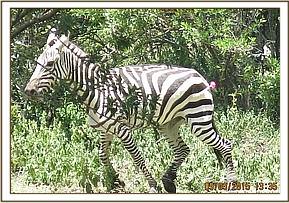

Examination revealed a tight winch wire snare round her fetlock joint that had eaten into joint tissues partially damaging some joint ligaments. The wire was cut loose leaving a raw wound. The wound was thoroughly cleaned and disinfected with tincture of Iodine. Oxytetracycline wound spray was then applied. In addition, the zebra was given an intramuscular injection of 3000mgs Amoxicillin antibiotic to counter sepsis.
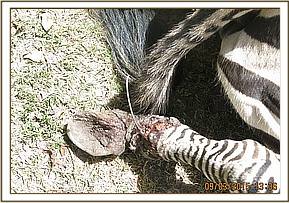

Reversal
Reversal was achieved by intravenous administration of 18mgs Diprenorphine hydrochloride through the jugular vein. The zebra woke up two minutes after revival to join the rest of her herd nearby.


Prognosis
Good.
CASE#6 TREATMENT OF AN INJURED LION
Date: 10th Mar 2015
Species: Lion
Sex: Male
Age: Young adult (2.5yrs)
Location: Musiara, near Governor’s camp
History
This young male, a member of the Marsh Pride of lions, was seen with a swollen left cheek and his left eye also appeared sore. His pride was seen feeding on a kill earlier but he appeared disinterested. Governor’s camp management sought the Veterinary Unit’s help.
This lion was found with other members of the pride under a tree. He appeared to be in pain but his body condition was good.
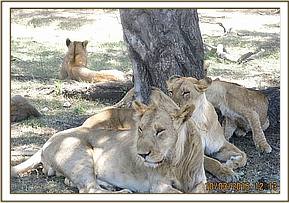

Immobilization, examination and treatment
The lion was chemically restrained by use of a combination of 2mgs Medetomidine and 200mgs Ketamine in a 3ml Dan-inject dart from a vehicle. He remained calm after darting before being fully anaesthetized after eight minutes and a blindfold applied. Examination revealed injury to the left side of his head likely caused by a blow. The upper and lower canines on this side of the face were broken with bleeding gums and the tissues around the eye were also swollen. The eye appeared red with partial prolapse of the third eyelid due to swelling.


The injuries appeared to have been inflicted by a kick either from a buffalo or a zebra and the damage was restricted to the teeth and soft tissues. Examination revealed the jaw was not dislocated and opened and closed with ease with normal limited lateral movement. The swollen gums were massaged gently and blood clots wiped out. Clean water was used to rinse the oral cavity in order to check for any lacerations. The affected eye was rinsed with clean water and subconjuctival injection of a combination of Dexamethasone sodium anti-inflammatory and Amoxicillin antibiotic was given.
Cloxacillin eye ointment was also applied to both eyes to prevent desiccation. Additional parenteral administration of 16mgs Dexamethasone sodium and 2250mgs Amoxicillin was given intramuscularly.
Reversal
Reversal was achieved by intramuscular administration of 10mgs Atepamezole hydrochloride one hour after immobilization. The lion work up after 20 minutes and joined the other pride members.
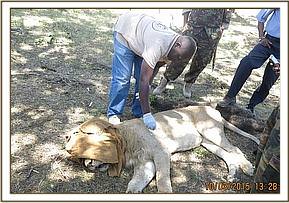

Prognosis
Good.
CASE#7 TREATMENT OF AN ELEPHANT WITH BULLET WOUNDS
Date: 12th March 2015
Species: African elephant
Sex: Female
Age: Adult
Location: Mara Bush tops
History
This elephant cow was seen by management of Mara Bush Tops camp isolated and limping on both of her front limbs. They called the vet unit for help.
This elephant was in a small thicket having moved to about 300meters from where she was originally spotted. Though still feeding, she appeared to be in pain while moving. An injury was obvious on mid of her left limb.
Immobilization, examination and treatment
Restraint was achieved chemically by use of 15mgs Etorphine hydrochloride delivered through a 3ml Dan-inject dart from a vehicle at the edge of a small bush. The drugs took effect after 9 minutes with the elephant assuming right lateral recumbency. She did not move after darting but remained on the spot until the drugs took full effect.


Examination revealed injuries to both front limbs. There was a small penetrating wound on the lateral surface of the left limb which continued to exit on the inner surface tearing muscles and leaving a big gaping wound. The right carpal joint had a shallow crease on its inner surface and the joint integrity was not affected. All the damage was restricted to the soft tissues and no fractures were detected.


The injuries were most likely caused by a blow from a high velocity projectile which exited and could not be retrieved. All the wounds were cleaned with copious amount of water, necrotic tissues removed with the help of Hydrogen peroxide and gauze swabs, and disinfection with tincture of Iodine. Oxytetracycline spray was applied topically before green clay was packed into the wound. Additional treatments involved intramuscular administration of 15000mgs Amoxicillin antibiotics and 3500mgs Flunixin meglumine anti-inflammatory.
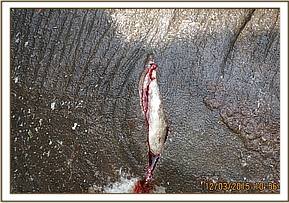

Reversal
Reversal was achieved by intravenous administration of 42mgs Diprenorphine hydrochloride through the ear vein. The elephant woke up in three minutes and moved off into a nearby thicket.


Prognosis
Good.
Given that damage was restricted to soft tissues alone, there are high chances the elephant will recover. A follow up treatment is to be carried out after 3 weeks. Meanwhile the Mara Bush Tops rangers are monitoring this elephant with regular updates on her condition.
CASE#8 EUTHANASIA OF A YOUNG ELEPHANT BULL
Date: 13th March 2015
Species: African elephant
Sex: Male
Age: 15-17 years
Location: Trans Mara
History
This elephant was seen recumbent on the bed of a sharp rocky valley by local herders. They informed The Mara North Conservancy rangers who sought our help.
Examination and case management
This elephant had fallen from an 80 feet cliff into a rocky valley. He appeared to have fractured his spine with both hind legs immobile. He could hardly raise his head and trunk. Examination showed that this elephant could have been in that position for at least five days with bed sores developing on the laid upon areas. There was also evidence of rhabdomyolysis as a result of pressure on muscles and long stay in that position.


After thorough clinical assessment of this animal, his prognosis was considered grave and euthanasia was advised to end his suffering. Both tusks were taken by KWS security team for accountability and safe custody.
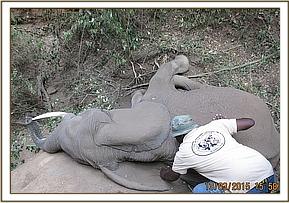
CASE#9 TREATMENT OF AN ELEPHANT BULL WITH SPEAR WOUND
Date: 16th March 2015
Species: African elephant
Sex: Male
Age: Adult
Location: Olkinyei conservancy.
History
This massive elephant was seen injured and reported to the Mobile Veterinary Unit by Olkinyei Conservancy Management.
This elephant was found in a group of 15 elephants near a small valley. He appeared in pain and walked behind the rest of the elephants. His left abdomen had been punctured and was bleeding with part of the omentum hanging out.


Immobilization, examination and treatment
Immobilization was achieved by use of 17mgs Etorphine hydrochloride delivered through a 3ml Dan-inject dart from a vehicle. It took ten minutes for the elephant to be fully narcotized falling down to assume right lateral recumbency. Pinna of the ear was used as blindfold and plenty of water used to keep him cool.


Examination revealed a penetrating wound likely caused by spearing with omentum popping through the opening. The wound was less than 24hours old and was still bleeding.
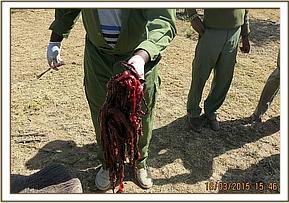

Area around the wound was thoroughly cleaned and exposed areas of omentum trimmed. All bleeders were ligated using No 2USP chromic catgut and clean omentum pushed back into the abdomen. Once in its right position, the peritoneum was closed with No 2 USP chromic catgut using a simple interrupted suture pattern. Muscle layers were also apposed using same suture and pattern. Skin was closed using No 2 USP braided polyglactine suture applied in a simple interrupted pattern. A small opening was left ventrally for purposes of drainage. The wound was then infused with Cloxacillin ointment and packed with green clay. In addition, this elephant received 15000mgs Amoxicillin antibiotic to counter sepsis.
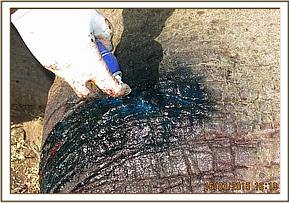

Reversal
Reversal was achieved by administration of 36mgs Diprenorphine hydrochloride intravenously through the ear vein. He woke up after four minutes and moved towards the other herd members.


Prognosis
Good. This elephant was seen one week later in good state.
CASE#10 ELEPHANT CALF RESCUE
Date: 17th March 2015
Species: African elephant
Sex: Female
Age: 11-14 months
Location: Near Mara Bridge
History
This baby elephant was seen by visiting tourists who in turn informed the Mara Triangle Conservancy Rangers. The Mara Triangle management requested The Veterinary Units assistance in rescuing this calf.

Capture
This baby was found wandering alone in plains close to Mara Bridge. Closer examination revealed her tail had been bitten off by hyenas. Part of her external genitalia also had injuries from a hyena attack. Despite this, overall her condition was good. She was manually captured and restrained by use of ropes before loading her into a truck enroute to Serena Airstrip. At the airstrip, she was given an intramuscular injection of 3000mgs Amoxicillin antibiotic to counter sepsis. A plane sent from Nairobi picked her up and took her to David Sheldrick Orphanage for further treatment.
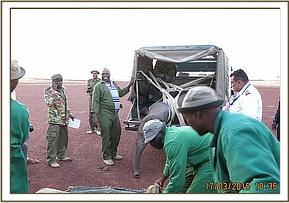
CASE#11 BLOOD COLLECTION FROM AN ELEPHANT
Date: 20th March 2015
Species: African elephant
Sex: Male
Age: Adult; approx. 35 years old
Location: Masai Mara Reserve
History
Serum extracted from healthy adult individuals can be given to young orphans to boost immunity and protect against some conditions. Mature healthy bulls are normally good candidates for this.
Immobilization and blood collection
Immobilization was achieved by use of 17mgs Etorphine hydrochloride delivered through a 3ml Dan-inject dart from a vehicle. It took nine minutes for the drugs to take full effect with the elephant going down on his lateral side.
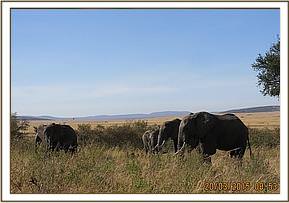

The left superficial ear veins were disinfected before blood was collected from these areas. A total of ten pints of whole blood was collected and immediately sent to competent laboratories for processing. This elephant received 15000mgs Amoxicillin antibiotic for prophylaxis.
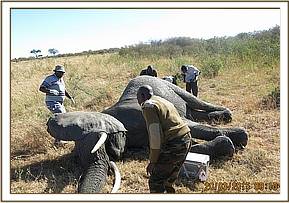

Reversal
Reversal was achieved by administration of 42mgs Diprenorphine hydrochloride intravenously through the ear vein. He woke up after three minutes to join other members of the herd.
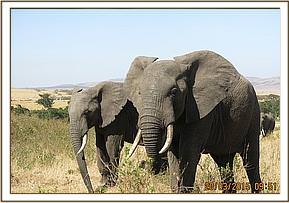
CASE#12 TREATMENT OF A LIONESS GORED BY BUFFALO
Date: 27th March 2015
Species: Lion
Sex: Female
Age: Young adult
Location: Mara North Conservancy.
History
Mara North Conservancy Rangers together with Management of Cheetah camp saw this injured lioness isolated from the rest of the pride which was feeding on a young buffalo kill. She had a puncture to her ventral abdomen and her intestines were hanging out. They called the Vet Unit for help.
The Vet Unit found the lioness lying on a rocky area seemingly in pain. The rest of the pride, comprising of her mother and two brothers, were nearby. When agitated to stand, she did so with pain and difficulty. At this point, loops of intestines with omentum were seen dangling from the wound. Decision to immobilize and carry out closer examination was arrived at.
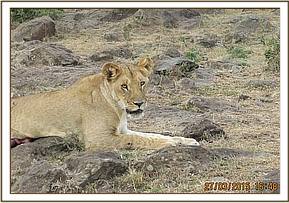

Immobilization, examination and treatment
Immobilization was achieved by use of combination of 4mgs Medetomidine and 200mgs Ketamine delivered in a 3ml Dan-inject dart from a vehicle. The lioness was fully anaesthetized after seven minutes. A blindfold and Cloxacillin ointment was applied to the both eyes. After making sure she was stable, the examination of injury was carried out.
This lioness appeared to have received a nasty gore from a buffalo which punctured her ventral abdomen resulting in exteriorization of abdominal organs. Apart from the small and large intestines, the uterus and ovaries were also dangling. The opening was small and had caused considerable strangulation to these organs. Though there was no puncture detected on these organs, their long exposure to dry and windy environment had resulted in some degree of desiccation.
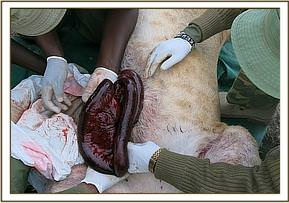

The exposed intestines were thoroughly washed with clean water and contaminated areas of ometum trimmed out. The puncture wound was enlarged for ease of retropulsion of exteriorized organs. Wound margins were shaved clean and disinfected with tincture of iodine. Once pushed back into the abdomen, 1500mgs of Amoxicillin antibiotic was infused into the peritoneal cavity through the opening. The peritoneum was secured by No 2 USP chromic catgut suture using purse string suture pattern. Muscle layers were also apposed with No 2 USP chromic cat gut suture using simple interrupted pattern. The subcuties were also secured by use of No2 USP chromic catgut and subcutaneous suture pattern. At this point, all the sutured layers were infused with cloxacillin ointment and the ski closed using No 1 USP polyglactine suture. Oxytetracycline spray was then applied topically. Additional treatment included intramuscular injection of 3000mgs Amoxicillin antibiotic and subcutaneous administration of 70mgs Ivermectin parasiticide.


Reversal
Reversal was achieved by intramuscular administration of 15mgs Atepamezole hydrochloride one hour after immobilization. The lioness woke up after 20 minutes but stayed for sometime on that spot. The rest of the pride members closed in to provide protection.
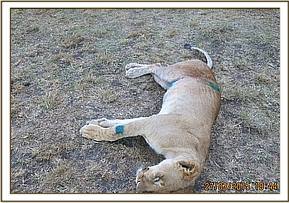

Prognosis
Guarded. Prolonged exposure and strangulation of the intestines could result to desiccation and ischaemia.This despite the intervention could lead to intestinal complications and death. Future viability of the exposed parts of the intestines is not guaranteed.
CASE#13 TREATMENT OF ELEPHANT COW WITH A SPEAR WOUND
Date: 28th March 2015
Species: African elephant
Sex: Female
Age: Adult.
Location: Naboisho conservancy.
History
This elephant nursing a three year old calf was seen with a wound on her left flank by Naboisho Conservancy Rangers. They informed their manager who in turn called the Veterinary Unit for help.
This elephant with an approximately three year old calf was in a group of about 100 elephants who had recently moved to Naboisho Conservancy. She had a discharging wound to the upper side of her left flank with noticeable swelling ventral to the wound. The swelling appeared to be caused by accumulation of pus. Overall she appeared healthy and feeding normally.
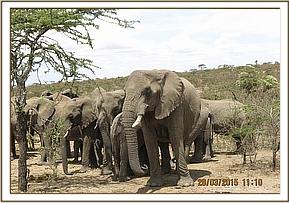

Immobilization, examination and treatment
Restraint was achieved chemically by use of 16mgs Etorphine hydrochloride delivered in a 3ml Dan-inject dart from a vehicle. The drugs took full effect after ten minutes with the elephant assuming sterna recumbency. She was immediately pushed over to lie on her right side for safety and easier handling of the wound. The pinna of the ear was used as blindfold with Cloxacillin eye ointment applied to both eyes to avoid desiccation.
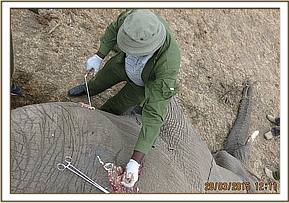

Examination revealed a spear inflicted septic wound on the upper portion of her left flank. The spear had since fallen with the wound discharging purulent stuff. The wound was ventro-medially directed with more pus accumulating ventrally without ventral outlet. This was like a pouch. After aspiration to confirm it was indeed pus that had caused ventral swelling; an opening was created ventrally to facilitate drainage. All necrotic tissues were removed and pus drained out. Copious amount of water was used for cleaning the wound applying through and through lavage technique. Water was introduced through the more proximal opening and drained through the ventral opening. Hydrogen peroxide for debridement and Iodine for disinfection was also introduced the same way. After making sure the wound was clean, Oxytetracycline wound spray was applied topically and green clay packed. She was also given intramuscular injection of 15000mgs Amoxicillin antibiotic and 4000mgs Flunixin meglumine anti-inflammatory.
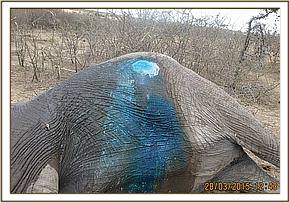

Reversal
Reversal was achieved by intravenous administration of 42mgs Diprenorphine hydrochloride through the superficial ear vein. The elephant woke up after four minutes and walked to join the rest of the group.
Prognosis
Good.
CASE#14 TREATMENT OF A GIRAFFE WITH SPEAR WOUND
Date: 30th March 2015
Species: Masai giraffe
Sex: Male
Age: Adult
Location: Olare Orok conservancy.
History
This giraffe was seen with a spear sticking out of his upper left flank by Olare Orok Conservancy rangers. They informed the management who called The Mobile Veterinary Unit for assistance.
This giraffe was alone in a sparsely wooded area with no other giraffes seen nearby and he appeared in great pain. The spear was deeply embedded with ruminal contents seeping from the entry.
Immobilization, examination and treatment
Immobilization was achieved by administration of a combination of 12mgs Etorphine hydrochloride and 50mgs Azaperone in a 3ml Dan-inject dart from a vehicle. The drugs took effect after eight minutes and the giraffe brought down with the help of ropes. He was blindfolded and made to lie on his right side for ease of examination. He was reversed immediately with 36mgs Diprenorphine hydrochloride delivered intravenously through the jugular vein.
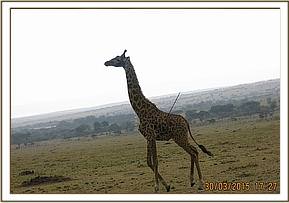

The spear was gently removed with bloody ingest seeping through the opening. Up to one meter of the spear had entered right into the abdomen with potential damage to vital abdominal organs. It was unfortunate; this giraffe succumbed soon after the spear was removed due to vital organ damage.
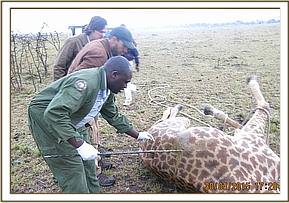

Conclusion
Mara mobile veterinary unit is grateful to all the stakeholders and partners who contributed immensely to wildlife rescues and treatments carried out during the month. Their reporting and assistance during treatment and rescue processes is highly appreciated. Thanks to Minara Foundation through The David Sheldrick Wildlife Trust for their continued facilitation to the unit. Thanks too to KWS management for the immense support to the unit. Without all of you, it would be difficult to achieve what we have over this period.
